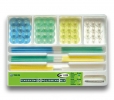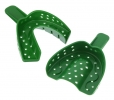IMPLANT PLACEMENT IN FAILED ENDODONTIC SITES: A REVIEW.
Dental implants may fail to osseointegrate in sites of endodontic failure. This may occur as a result colonization by various anaerobic and facultative bacterial species.
If an implant is placed in a site where vegetative bacteria are residing, the implant may fail to integrate if a bacterial colonization proceeds coronally. If the implant apical cortical bone is thin or if there is an apical fenestration the colonization may proceed through the thin or non-existent bone through the covering mucosa relieving inflammatory pressure to create an apical (retrograde) peri-implantitis.
Enterococcus faecalis may be a prime culprit in these implant failures. After thorough debridement, the implant may be immediately placed after extraction of an endodontically failed tooth and the patient treated with an appropriate antibiotic.
Alternatively waiting for post-extraction healing and subsequent implant placement can be done. Nevertheless either way may allow the formation of bacterial vegetative forms or biofilms. The implant surface may be colonized when the surface is exposed to the bacteria.
Thorough debridement is crucial. Nevertheless organisms may persist. Randomized controlled trials are needed to elucidate this issue.
Source: PMID: 26550925 [PubMed - as supplied by publisher]
Publication date: 2015 Nov 9





